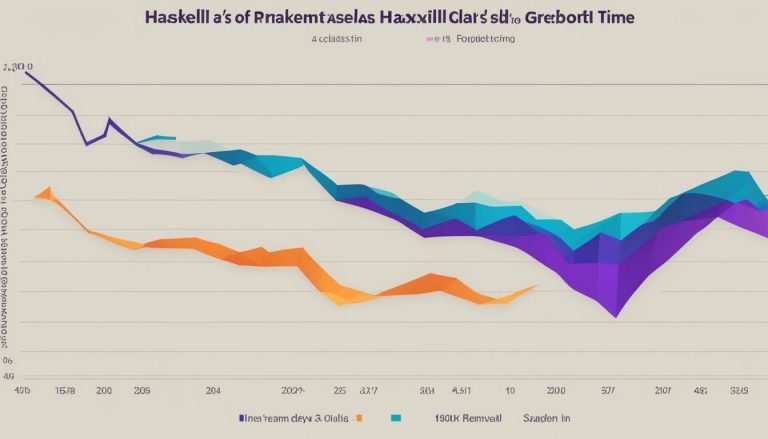Have you ever wondered what exactly a hash rate is when it comes to cryptocurrencies like Bitcoin? Well, you’re not alone. Understanding this concept is essential for anyone interested in cryptocurrency mining. Let me explain.
A hash rate refers to the speed at which a computer or network can perform mathematical calculations to mine cryptocurrencies. It measures the number of calculations that can be done per second. In simple terms, the higher the hash rate, the more calculations can be made, which increases the chances of successfully mining new blocks and earning rewards.
In cryptocurrency mining, hash rates play a critical role in determining the profitability of mining operations and the overall security of the network. It’s a key factor that miners need to consider when they enter the world of mining.
Key Takeaways:
- Understanding the hash rate is crucial for cryptocurrency mining.
- Hash rate refers to the speed at which calculations for mining can be performed.
- A higher hash rate increases the chances of successfully mining new blocks and earning rewards.
- Hash rates have a direct impact on the profitability and security of the network.
- Miners strive to improve their hash rates through hardware upgrades and software optimization.
Importance of Hash Rate in Cryptocurrency Mining
The hash rate plays a crucial role in cryptocurrency mining, impacting both the profitability of mining operations and the security of the blockchain network. A higher hash rate increases the chances of successfully mining new blocks and earning block rewards, which are essential for mining profitability. Miners with higher hash rates have a competitive advantage as they can solve complex mathematical problems faster than others, increasing their chances of being the first to validate transactions and earn rewards.
Furthermore, a higher hash rate enhances the security of the blockchain network by making it more difficult for malicious actors to perform a 51% attack. In a 51% attack, a single entity or group controls more than 50% of the network’s hash rate, allowing them to manipulate transactions, double-spend coins, or invalidate transactions. However, with a higher overall hash rate, it becomes exponentially more challenging for an attacker to control the majority of the network’s computing power, making the network more secure and resistant to such attacks.
In summary, a higher hash rate not only increases the profitability of mining operations but also contributes to the overall security and integrity of the blockchain network. Miners continuously strive to improve their hash rates by upgrading their mining hardware, optimizing their mining software, and benchmarking their performance against industry standards. By doing so, they can maximize their mining potential, increase their chances of earning rewards, and maintain their competitive edge in the dynamic world of cryptocurrency mining.
How Hash Rate Works in Cryptocurrency Mining
In cryptocurrency mining, the hash rate plays a crucial role in determining the mining potential and overall performance. The hash rate is a measure of the processing power of the mining hardware, and it directly impacts the speed at which calculations can be performed to mine cryptocurrencies like Bitcoin.
Miners use specialized computer hardware, such as ASICs (Application-Specific Integrated Circuits), which are designed specifically for mining purposes. These hardware devices are capable of solving complex mathematical problems and generating hash functions that validate and process transactions on the blockchain.
The more powerful the mining hardware, the higher the hash rate. This means that miners with higher hash rates can perform a greater number of calculations per second, increasing their chances of successfully mining new blocks and earning rewards. It is important for miners to continually optimize their hardware and stay updated with the latest advancements in order to maximize their hash rates and remain competitive in the mining industry.
Table: Comparison of Hash Rates in Cryptocurrency Mining Hardware
| Hash Rate | Mining Hardware |
|---|---|
| 10 TH/s | ASIC A |
| 20 TH/s | ASIC B |
| 30 TH/s | ASIC C |
The table above showcases a comparison of hash rates in different cryptocurrency mining hardware. As seen, the higher the hash rate, the more powerful the hardware. Miners can choose hardware with higher hash rates to increase their mining potential and improve their chances of earning rewards.
In summary, the hash rate in cryptocurrency mining is determined by the processing power of the mining hardware. Miners strive to maximize their hash rates by utilizing powerful mining hardware and staying updated with the latest advancements. By doing so, they can enhance their mining potential, increase their chances of successfully mining new blocks, and ultimately, improve their overall profitability in the world of cryptocurrency mining.
Improving Hash Rate in Cryptocurrency Mining
When it comes to cryptocurrency mining, improving the hash rate is crucial for maximizing mining potential and profitability. Miners can enhance their hash rates by employing various strategies and techniques. Let’s explore some effective methods for improving hash rates in cryptocurrency mining.
Focusing on Hardware
One way to boost the hash rate is by using more powerful mining hardware. Upgrading to the latest ASICs (Application-Specific Integrated Circuits) can significantly increase computational power and efficiency. Additionally, miners can consider using multiple mining rigs to scale up the hash rate. By investing in superior hardware, miners can stay competitive and optimize their mining potential.
Optimizing Mining Software
Optimizing mining software is another key approach to improving hash rates. Miners can fine-tune their mining software settings and adjust parameters to leverage the full potential of their hardware. By optimizing software, miners can eliminate inefficiencies and ensure smoother, faster mining operations, resulting in improved hash rates.
Benchmarking Hash Rates
Miners often benchmark their hash rates against industry standards to evaluate their mining performance. Benchmarking provides valuable insights into how a miner’s hash rate compares to others in the field. By analyzing benchmark results, miners can identify areas for improvement and fine-tune their strategies to achieve higher hash rates. Keeping up to date with the latest hash rate benchmarks is crucial for staying competitive in the dynamic world of cryptocurrency mining.
| Benchmark | Hash Rate (in TH/s) | Hardware |
|---|---|---|
| Benchmark 1 | 120 | ASIC A |
| Benchmark 2 | 150 | ASIC B |
| Benchmark 3 | 180 | ASIC C |
Table: Comparison of hash rates achieved by different ASIC hardware benchmarks.
By implementing these strategies and continuously optimizing hash rates, miners can enhance their mining performance, increase profitability, and stay competitive in the ever-evolving world of cryptocurrency.
Calculating Hash Rate
Calculating hash rate is a fundamental step in understanding the performance and efficiency of cryptocurrency mining operations. By knowing the hash rate of a mining rig or network, miners can gauge their potential in solving complex mathematical problems and earning block rewards. The formula for calculating hash rate is straightforward:
Hash Rate = Total Hashes / Time
Here, “Total Hashes” refers to the number of calculations or hash functions performed by the mining hardware within a specific time period, while “Time” represents the duration of that time period. By dividing the total number of hashes by the time taken, we can determine the hash rate, which is typically measured in hashes per second (H/s), kilohashes per second (kH/s), megahashes per second (MH/s), or even gigahashes per second (GH/s).
It’s important to note that the actual hash rate achieved may vary due to factors such as hardware limitations, network congestion, and mining software efficiency. Therefore, it’s advisable to calculate the hash rate over an extended period of time to obtain a more reliable average value.
For example, let’s say a mining rig generates 1,000,000 hashes in 10 minutes. To calculate the hash rate:
Hash Rate = 1,000,000 hashes / (10 minutes x 60 seconds) = 1,666.67 H/s
By applying the hash rate formula, miners can accurately assess the performance of their mining operations and make informed decisions to optimize their efficiency and profitability.
| Calculation | Value |
|---|---|
| Total Hashes | 1,000,000 hashes |
| Time | 10 minutes x 60 seconds = 600 seconds |
| Hash Rate | 1,666.67 H/s |
The Relationship between Hash Rate and Mining Profitability
When it comes to cryptocurrency mining, the hash rate plays a significant role in determining the overall profitability of the mining operation. The hash rate represents the speed at which a computer or network can perform calculations to mine cryptocurrencies like Bitcoin. A higher hash rate means more calculations can be completed per second, increasing the chances of successfully mining new blocks and earning block rewards.
With each block reward, miners receive a certain amount of cryptocurrency as an incentive. Therefore, a higher hash rate directly translates to greater mining rewards and increased profitability. Miners with higher hash rates have a competitive advantage as they can solve complex mathematical problems faster than others, increasing their chances of earning block rewards.
However, it’s important to note that hash rate is not the sole factor determining mining profitability. Electricity costs, mining difficulty, and other operational expenses also need to be considered. Miners should assess the overall cost of mining, including energy consumption, hardware maintenance, and cooling, against the potential mining rewards to determine their profitability.
Factors Affecting Mining Profitability
- Hash Rate: A higher hash rate increases the likelihood of successfully mining new blocks and earning block rewards, leading to greater profitability.
- Electricity Costs: Mining requires a significant amount of electricity, and higher electricity costs can eat into potential mining profits.
- Mining Difficulty: Mining difficulty adjusts dynamically to maintain a consistent block generation time. As mining difficulty increases, it becomes harder to mine new blocks, potentially reducing mining profitability.
- Hardware Efficiency: Utilizing more efficient mining hardware can increase hash rates while reducing energy consumption and operational costs, contributing to improved profitability.
- Market Conditions: Cryptocurrency prices can have a significant impact on mining profitability. Fluctuations in market prices can affect the value of block rewards, influencing overall profitability.
By carefully monitoring and optimizing their hash rates, considering operational expenses, and staying up to date with market conditions, miners can maximize their mining potential and strive to achieve profitable returns from their mining operations.
| Factor | Impact on Mining Profitability |
|---|---|
| Hash Rate | Higher hash rates increase the chances of mining new blocks and earning block rewards, leading to greater profitability. |
| Electricity Costs | Higher electricity costs can reduce mining profitability by cutting into potential profits. |
| Mining Difficulty | Increased mining difficulty can decrease mining profitability as it becomes harder to mine new blocks. |
| Hardware Efficiency | Using more efficient mining hardware can increase hash rates and reduce operational costs, contributing to improved profitability. |
| Market Conditions | Fluctuations in cryptocurrency prices can impact the value of block rewards and, consequently, mining profitability. |
Conclusion
The hash rate is a critical factor in cryptocurrency mining, impacting the mining potential, profitability, and security of the blockchain network. As a miner, I strive to constantly improve my hash rate to stay competitive in the ever-evolving world of cryptocurrency.
To achieve a higher hash rate, I focus on two key areas: hardware and software optimization. Upgrading to more powerful mining hardware, such as the latest ASICs, can significantly boost the hash rate. Additionally, I optimize my mining software and adjust mining parameters to maximize efficiency.
It’s important for me to benchmark my hash rate against industry standards to measure my mining performance. This allows me to identify areas for improvement and stay ahead of the competition. By continuously monitoring and optimizing my hash rate, I can maximize my mining potential and increase my chances of earning greater rewards.
Understanding the importance of hash rate and its relationship with mining profitability is crucial for anyone interested in cryptocurrency mining. By staying knowledgeable and adaptable, I can navigate the dynamic landscape of cryptocurrency mining and stay on top of hash rate benchmarks.
FAQ
What is a hash rate?
A hash rate refers to the speed at which a computer or network can perform mathematical calculations to mine cryptocurrencies like Bitcoin. It measures the number of calculations that can be performed per second.
Why is hash rate important in cryptocurrency mining?
The hash rate is crucial in cryptocurrency mining as it determines the profitability of mining operations and the overall security of the network. A higher hash rate increases the chances of successfully mining new blocks and earning rewards.
How does hash rate work in cryptocurrency mining?
The hash rate is determined by the processing power of the mining hardware. Miners use specialized computer hardware, such as ASICs, to perform calculations and solve complex mathematical problems. The more powerful the hardware, the higher the hash rate.
How can I improve my hash rate in cryptocurrency mining?
Miners can improve their hash rates by using more powerful mining hardware or optimizing the performance of their existing hardware. Upgrading to the latest ASICs or using multiple mining rigs can significantly increase the hash rate. Additionally, optimizing the mining software and adjusting mining parameters can also enhance the hash rate.
How do I calculate hash rate?
Hash rate is calculated by dividing the total number of hashes generated by the mining hardware in a given time period by the duration of that time period. The formula for calculating hash rate is: [Total Hashes Generated] / [Time Period].
What is the relationship between hash rate and mining profitability?
A higher hash rate increases the likelihood of successfully mining new blocks and earning block rewards, which are essential for mining profitability. Miners with higher hash rates have a competitive advantage as they can solve complex mathematical problems faster than others.
Can I benchmark my hash rate?
Yes, miners often benchmark their hash rates against industry standards to measure their mining performance and identify areas for improvement. Benchmarking helps miners stay competitive in the ever-evolving world of cryptocurrency.
Cathy is a senior blogger and editor in chief at text-center.com.


